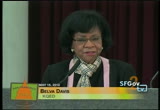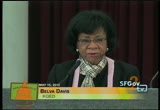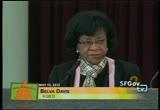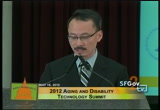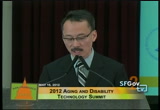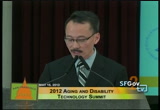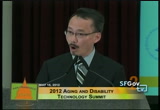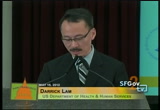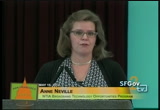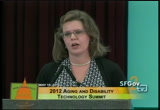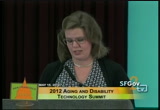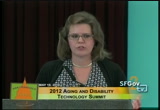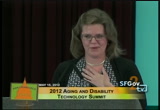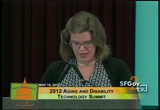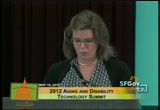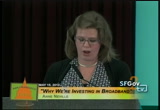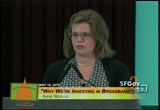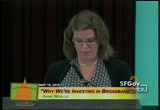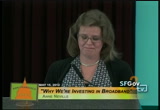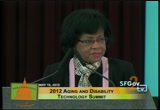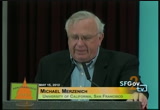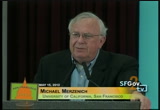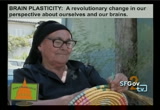tv [untitled] February 11, 2013 8:00pm-8:30pm PST
8:00 pm
because i was where i have a house that i am trying to put on the market, and the traffic from there to here was over two hours. in the meantime, i wanted to let people here know what was going on with me. so with my cell phone, i called a friend who called somebody. they called somebody. and i made it here. because she knew how to use her computer and resources. i am with you. i need more lessons, obviously. i had the phone but not the knowledge. we're going to do something about that in my household. we're also doing something about living that far away from the center of everything, which is right here in the city. if you want to buy a house in the country would to a half acres, i have got one for you. it is is the morning as we all evolves, and as my husband and i get closer to 80, both of us have retired two times already. we're now getting ready for a third got around to remember, you could do as many as you like, too, because you're the only one that can say i am tired of doing that and i do not want
8:01 pm
to do it anymore. that is right. we have some people with real knowledge and not chitchat to come up and tell us how we can age at the same time that we are gaining insight, knowledge, and exposure to a vast universe of information and opportunity. so we are going to start with derek lamb, an aging service program specialist for the newly reorganized administration for community living here in region 9, the department of health and human services. he has over 23 years of experience in the field of aging and long-term support services. he served as the aging service program specialist since -- 19, ok. not a kid would say 1906 and in 2006.
8:02 pm
2002-2005. we asked him to join us here with some wise remarks. [applause] >> good morning, everyone. can you hear me? all right. well, on behalf of the original administrator for the newly created administration for community living, i would like to congratulate the city and county of san francisco for launching the 2012 aging and disability technology summit. it was approximately a month ago that secretary kathleen sebelius said the u.s. department of health and human services announced the creation of this new federal agency, and that is the administration for community living. and in her words, she said "for
8:03 pm
too long, too many americans have faced the a possible choice between moving to an institution or living at home without the long-term services and support they need." so this new administration for community living will be to helping people with disabilities, as well as seniors, to live a productive, satisfying lives. now, as you may be aware, the aging and disability population has been recognized actually at the local and state levels for quite some time now. so the mechanisms for providing support that facility community living have been really brought together into local and state agencies such as the san francisco departments the of aging and adult services that serves those populations since the year 2000.
8:04 pm
yet, at the federal level, policy developments from a community outreach, and program implementation related to aging and disability services across the nation [unintelligible] across the department of health and human services until now. the obama administration, as well as secretary sebelius, have long been committed to promoting community living and finding new means to help ensure that we support the seniors and people with disabilities and making sure the committee is accessible. approximately three years ago, our nation commemorating the 10th anniversary of the homestead decision. in this time, president obama launched the community living initiative on june 22, does a 9 to reaffirm the administration's commitment -- 2009 and to reaffirm the administration's commitment for americans with
8:05 pm
disabilities and ensuring the full inclusion of all people in our nation. on the very same day, secretary sebelius set up an interagency coordinating council led by assistant secretary cathy green lake, as well as the director of the office of disability, henry klebold, to look at solutions that address various community living. and to give people more control over their lives and the support they need. now talking about this new agency, we are bringing together the administration on aging, which you may be very familiar with, the office of disability, as well as the administration on the developmental disabilities into one single agency. this support is growing crosscutting initiatives as well as efforts focused on the unique needs of individual groups such as seniors with dementia or children with developmental disabilities.
8:06 pm
the day-to-day management of the programs under the administration on aging and the administration of developmental disabilities will relatively remain unchanged, with the current program staff containing the assignments. kathy is now the administrator for the new federal agency. henry, the former director of the office of disability, is now the principal deputy administrator and remains a senior adviser to secretary sebelius on issues pertaining to disabilities. so that is the disability committee. we have direct access to the secretary. chairman louis is the commissioner for the administration for now the newly formed intellectual and developmental disabilities. on that the aging said, mr. walker serves as the deputy assistant secretary for aging, advocating on behalf of older americans. now this new federal agency will
8:07 pm
seek to enhance and improve a broad range of support that individuals may need to live with respect and dignity as full members of our community. this needs to go well beyond health care. it includes the availability of private housing, employment, education, meaningful relationships, as well as social participation. in addition, we will be working with the centers for medicare and medicaid services to develop, refine, and strengthen policies that promote independent living among all populations, especially those served by medicaid. we would also look with cms to promote home and community-based services and support. last but not least, i will be remiss if i forget to mention that may is also the time of the year when communities across nations come together to celebrate the older americans
8:08 pm
month. the proud tradition that shows our nation's commitment to recognize is the -- recognizing the contributions and achievements of our seniors. the theme for this year is "never too old to play." we want to encourage older americans to be engaged, active, and involved in your own lives and in your own communities. in closing, thank you so much for inviting me to speak at your summit. we wish everyone the very best, and we want to commend san francisco for again launching this important event today, and that is connecting seniors and people with disabilities to a world of possibilities. thank you very much, everyone. [applause] >> i think this program certainly is set up in the right order. learn something about your topic, and when you go to play, you'll understand the importance
8:09 pm
of what you have learned and you can feel smarter about it. we have a lot of smart people that are going to be on the stage here. right now, it is ann neville's turn. she is part of the initiative. in that capacity, she is responsible for both the development, the national broadband man up, and grants states to support broadband, not a collection. and these days broadband capacity in leadership effort. this is a very important job, believe me. i belong to a committee in washington called the minority media coalition, and our job is to stay on the federal agencies to make sure that minorities, those who consider themselves elderly and in need of help, and the disabled are included in this new world. so please welcome ann neville. [applause]
8:10 pm
>> good morning. can you hear me? good. well, thank you, everyone here today for the aging disability technology summit. it is an honor for us to be here today to support this important event for the city and county of san francisco. my name is ann, and i direct the state broadband initiative of the national telecommunications and information administration, which is in washington, d.c. our agency and tii is part of the u.s. commerce department, and it is the executive branch agency that is in charge of advising the president on telecommunications and information policy issues. we are at the forefront of the obama administration's push to establish a broadband foundation needed to support the innovation economy in the united states.
8:11 pm
we are looking to produce better and new jobs and position to ensure that america remains at the forefront of the economy in the 21st century. we are working to ensure that all americans have the resources and the skills necessary to fully share in all of the possibilities, civic, social, and economic. all of these made possible by the internet. that is one of the reasons we are here today. he discovered for the administration is the broadband technology opportunities program or btop. this program was established in 2009 by the american reinvestment and recovery act and is administered by ntia. we have nearly $4 billion invested in roughly 230 projects across the country, all aimed at expanding broadband access and
8:12 pm
adoption in the country. and i want to tell you a little bit about the programs and then tell you about why we care so much about this issue. so, we have the btop for infrastructure projects. these are building broadband networks in areas that are currently underserved. they are making sure that hospitals, schools, and other vital community institutions have the access that they need to make sure that they can compete in this economy. these projects are also going to spur private sector investment, and they're also going to increase availability for consumers at home. we also have btop computer centers. they're located in schools, libraries, fire stations, a community points all over the country, and they're providing broadband access to people who are hunting for jobs, to people who want to go online but do not have access at home, because
8:13 pm
maybe they do not have a computer or maybe they do not know how to use the internet. and we have the btop sustainable broadband adoption projects, like the one we are all part of here today. these projects are teaching computer and digital literacy skills to people who are not yet online and helping them to fully participate in a job market and is society that now takes these skills for granted. our portfolio of projects addresses barriers to access and adoption and provide broadband education, training, and equipment to all of these communities. i am here today because the city of san francisco was awarded a nearly $8 million award as part of the sustainable broadband adoption program. [applause] today's summit, the first of its kind, is a real milestone for this award and is something that
8:14 pm
we can look at across the country as a model. the grant is representative of 43 innovative broadband adoption projects currently being carried out across the nation. as the mayor mentioned earlier, san francisco is establishing or expanding computer labs in 53 locations around the city. these labs are operated by some 30 different non-profit organizations, housing providers, and community partners. these centers offer accessible touchscreen pc's with software that include brain fitness, microsoft office, and photo- video software in six different languages. english, chinese, spanish, russian, vietnamese, and curry in -- dorean. san francisco -- korean. san francisco has eight sub- recipients the more partners.
8:15 pm
volunteer teachers at one-on-one coaches in areas such as a social media, a health information, and job skills. this is truly a remarkable partnership, and it is an amazing accomplishment. and san francisco it really is in good company in this regard. ntia has invested $450 million for public computer centers and sustainable broadband adoption programs throughout the country. several of these also focus on older americans, and virtually all are providing public workstations equipped for people with disabilities. [applause] collectively, the result of this work in san francisco and in the city and -- cities and states across the country, will create templates for success that organizations around the rest of the country can replicate in order to help their communities move online. and getting communities online is the reason that we are so
8:16 pm
invested in this effort. it is critical to our future, because broadband drives economic growth, and broadband creates jobs. it provides the infrastructure that communities need to attract innovative businesses in a competitive, global landscape. broadband also allows businesses of all sizes to reach markets around the world. people who are aging or disabled have unfortunately historically been at the margins of new technologies when they are introduced. today, as broadband internet brings expanded opportunities in health care, education, and civic participation, projects like this one here in san francisco are critical to making sure that all communities have access to life changing technologies. [applause] high-speed internet connections make it possible for patients in rural areas to consult with
8:17 pm
medical specialists who are hundreds of miles away, for students to take online classes and universities across the country, and for governments to deliver services more efficiently and more easily to their constituents. for seniors, especially those whose families may live in different states or in different countries, broadband allows families to bond together in a way that telephone just never did. my own parents and all live in mexico city, and we are lucky because we both of broadband connections in our home. if a few weeks ago we got on skype. we set up the computer in our kitchen, and they set it up in their dining room but they instructed my husband and me as we tried to make one of their favorite meals. and they kind of scoffed when we were beating the dough too much and smiled when we had an almost
8:18 pm
round 40 a. for us, it is a the best way to connect because they live very far away and we do not get to see the mother rise. it is an important way for all of us to be able to connect with our families and with our communities. for americans living with disabilities, many of whom are also aging americans, broadband and commuters -- computers can provide even more critical tools for health and wellness. they allow someone with a speech impairment to e-mail her doctor, a person who is mobility limited to its in glasses -- classes online, and for someone else to work at home. 29% of people with disabilities would join the work force if telecommuting were actually a viable option for them. before working at home, however, broadband is now a necessity for anyone searching for a job. many job openings are only posted online. about 80% of fortune 500
8:19 pm
companies only accept job applications online. and about 60% of working americans use the internet as an integral part of their jobs every single day. if you do not have broadband, you are increasingly cut off from these opportunities. and unfortunately, ntia's own research shows that they're still too many americans who are on the wrong side of this and digital divide. in collaboration with the u.s. since then -- since his bureau, ntia conducts the most extensive survey work of broadband friends in the u.s., most recently in october 2010, not very long ago. it showed that 60% of americans subscribe to broadband. that is up to a 68% is up from 51% in 2007 and 64% in 2010. but that still leaves roughly one-third of americans who do not have access to the internet
8:20 pm
at home. also troubling, our survey reveals that there is still a substantial digital divide that breaks down a lot -- along traditional racial, ethnic, age, and geographical lines and by disability status. for example, 72% of white households had broadband access at home. compared with only 55% of african-american households and 57% of hispanic households. that is a 17 and 15-point difference. there is a similar divide between urban and rural america, where 70% of urban households have access at home, but only 57% of rural households are subscribing to broadband. seniors in people with disabilities also have far lower rates of adoption in the kent -- then the country as a whole. almost half of all households
8:21 pm
headed by someone with a disability did not have a computer. compare that to only 20% of households that do not have a computer if they were headed by someone without a disability. similarly, 43% of homes headed by someone with a disability subscribed to broadband compared to 72% of all homes, a 29-point difference. our data also shows that older americans, particularly those 65 and older, are less likely to live in a home with a computer or to have broadband internet access at home. and what is more, as we look further into this data, we found that when we looked at other socioeconomic factors, like in come or education, it did not fully explain it the gaps. even after accounting for a
8:22 pm
socio-economic and geographic factors, african-american and hispanic households still lack a white household in broadband adoption by 11 percentage points. at rural households still lacked urban households by five percentage points. these ongoing disparities and our critical need for our nation's future to overcome them are white today's summit is so important -- why today's summit is so important. the work san francisco is doing and has accomplished is important. together with our grantees, we're working on the frontline to close these gaps in injuring no one is left behind in the technical revolution. as of the end of 2011, the top grantees had installed your updated more than 45,000 miles of broadband telecommunications lines. they had upgraded and improved service to more than 6000
8:23 pm
anchor institutions. schools, libraries, hospitals across 35 different states. they install more than 29,000 workstations in public computer centers, and they had produced what is really amazing, 260,000 new broadband subscribers, as we hope many of you here today will become. the top projects are reaching every state and territory across the u.s., and at ntia, we're gratified to watch what this team has accomplished here in san francisco. to the top program overall, this project represents critical investments in the future of our nation, investments that are producing immediate benefits but are also going to pay dividends for years to come. thank you again for inviting us to be a part of today's summit. it is truly an honor, and we look forward to continuing to see more great projects and more
8:24 pm
wonderful events like this here in san -- in san francisco. thank you. [applause] >> well, as the kids say, that is information you can use. thank you so much. our next speaker is the co- founder and chief scientific officer of post-it science. he heads the company's goal team that has for more than three decades. he has been a leading pioneer in brain plasticity research. in the late 1980's, he was responsible for inventing something that i hope to own on my own, and in plans to approve my hearing. in 1996, he was the founder and
8:25 pm
ceo of scientific learning corporation, which markets and distributes software that applies principles of brain plasticity to assist children with language learning in reading. we are plowing -- proud to have him join us today to take part in this forum. [applause] >> thank you. i want to one-upping the mayor and say that today is my 70th birthday. [applause] still alive and raising cain. i also want to say that i am a proud citizen of this city and a public servant at the university of california, in this city for more than 45 years. it is wonderful to be here and wonderful to be with you today.
8:26 pm
i want to say, before i start, that you should understand that i was permitted by the university of california on a leave of absence from the science corporation, and i profit by what they do. at the end, i am going to talk about things that they do that a person can buy and understand that you can regard me as having a conflict of interest when i talk about things that i might profit by. i want you to know that. i also want to say that i will talk about science, because i am a nerd. it is officials. i want you to know that it is a team signs. hundreds of scientists and engineers and professional clinicians of different kinds and other technologists have contributed to it, and i represent them to a large extent is because i am the oldest, and certainly not because i am the smartest. so, i want to talk about your
8:27 pm
plastic brain. you have a very valuable asset inside your skull, of course, and that is your brain. it is very valuable, especially because it is plastic. i want to tell you what that means a tell you about the signs that shows us that that plasticity is actually result could again drive improvements in our abilities or, alas, it can take us backward into in a negative direction. i want to talk about what controls living in a positive or negative direction, because you sure do want to go in a positive direction. finally, want to talk about how we try to use this science with technology to help you sustain your brain health. i will give you advice about other things you can undo, whether your problem is a disability or you have that comment disability that applies to every one of us, you're simply having another birthday, like i am today. ok? on the path to a better, healthier, say few -- safer, and
8:28 pm
hopefully happier life. first, what you know that we used to think not very long ago, the predominant scientific view was that the brain grew up in the early life. it was a time of maturation. then it became fixed buying connectivity and wiring. then it was like a computer that was hard wired. and the only way it had to go from a very early point to a life was downhill. because it matured very early, basically there was a mysterious operating system and mysterious algorithms that accounted for your progression of learning, but as a physical and functional machine, it was stabbed in the only thing it did from a very early time in young child was to go south. we now know that is completely false. we now know that the brain is continuously changing. we now know that each time you acquire a new skill or ability, the brain is actually changing its wiring. id is actually changing its functionality. is actually specializing.
8:29 pm
answer that specialization, your account for the development of the skill or ability in play. we know this occurs throughout life. in fact commit to the end of life, because we know we can improve our ability and we can acquire a new skill to the end of life. here we have an older woman who has acquired a skill in later life, basket weaving. we know that because she has developed a special ability at this point in life, she has remodeled her brain, and that accounts for her developing of this expertise. this is in play in our lives and throughout our lives because our lives are so richly varied from early childhood onward, we create, through billions of moments of brain change, an incredible individuation of ourselves so that through these changes, we have a special ability is shared by no one else in this room in exact form. we have special
71 Views
IN COLLECTIONS
SFGTV2: San Francisco Government Television Television Archive
Television Archive  Television Archive News Search Service
Television Archive News Search Service 
Uploaded by TV Archive on

 Live Music Archive
Live Music Archive Librivox Free Audio
Librivox Free Audio Metropolitan Museum
Metropolitan Museum Cleveland Museum of Art
Cleveland Museum of Art Internet Arcade
Internet Arcade Console Living Room
Console Living Room Books to Borrow
Books to Borrow Open Library
Open Library TV News
TV News Understanding 9/11
Understanding 9/11